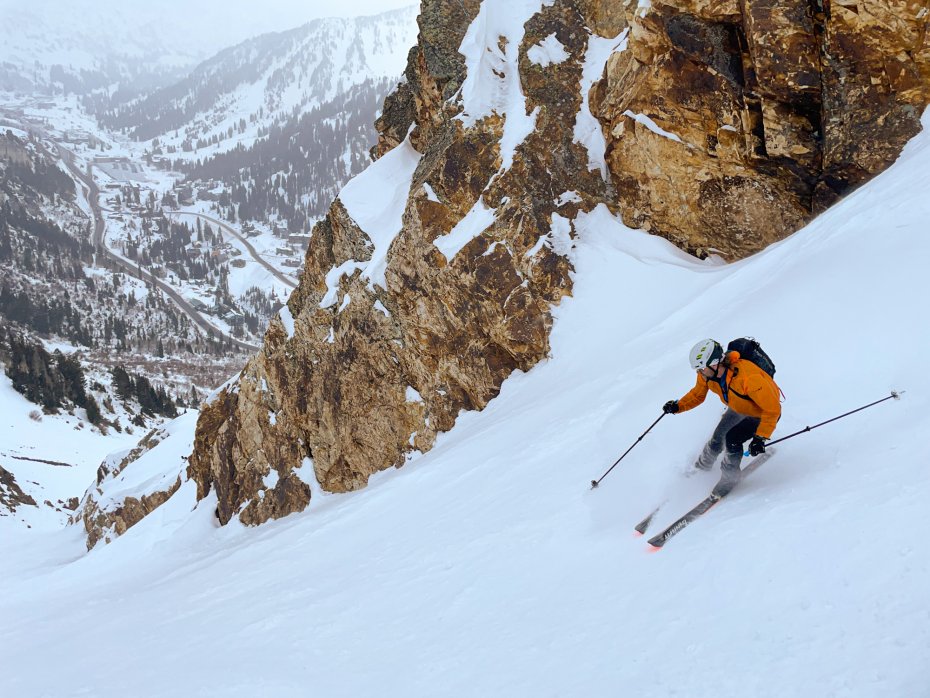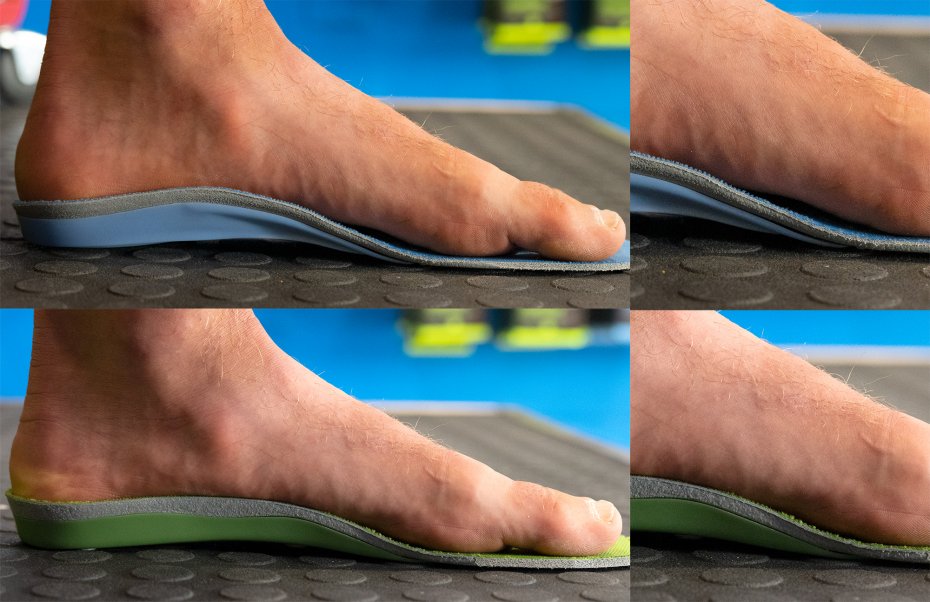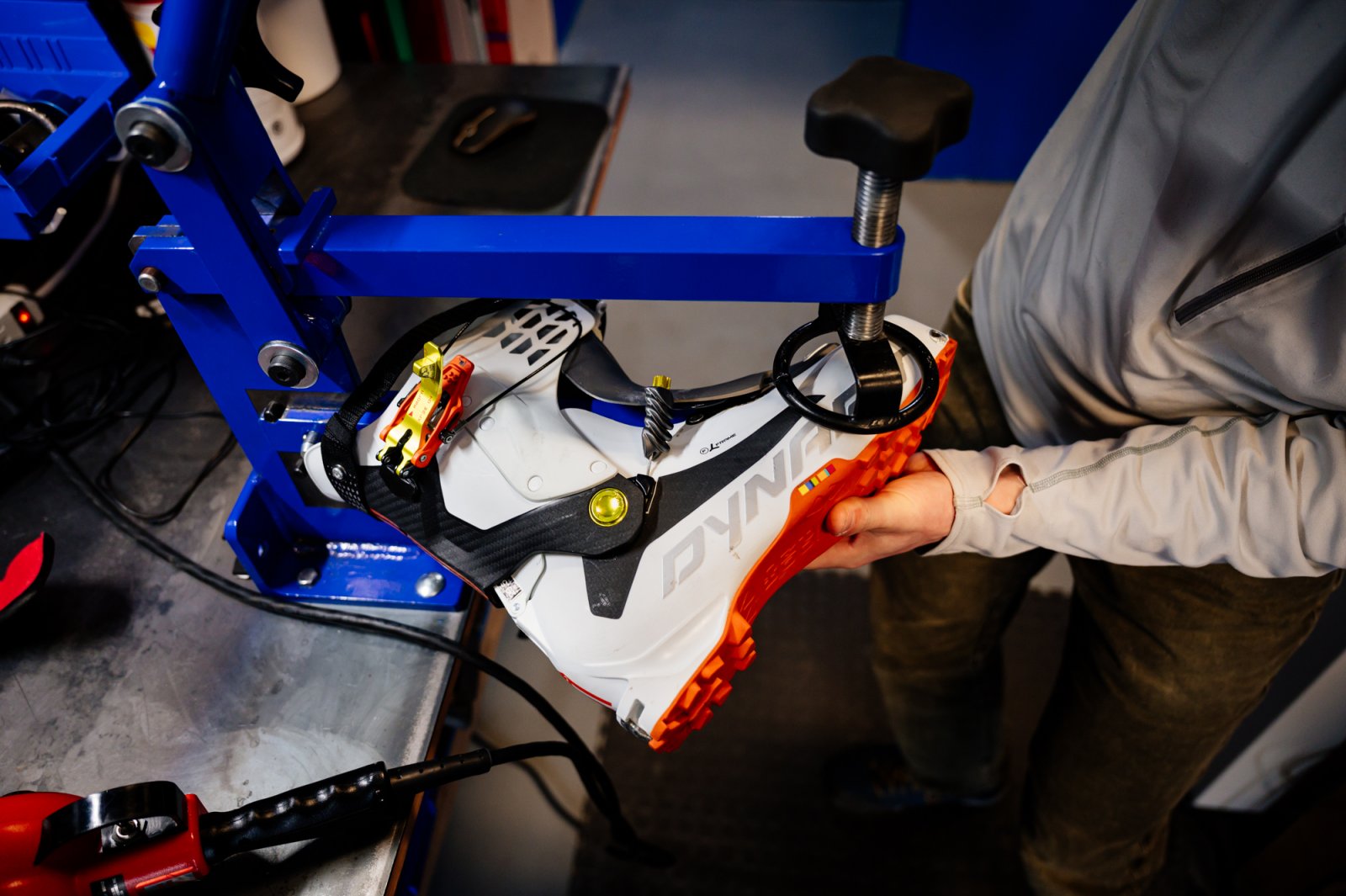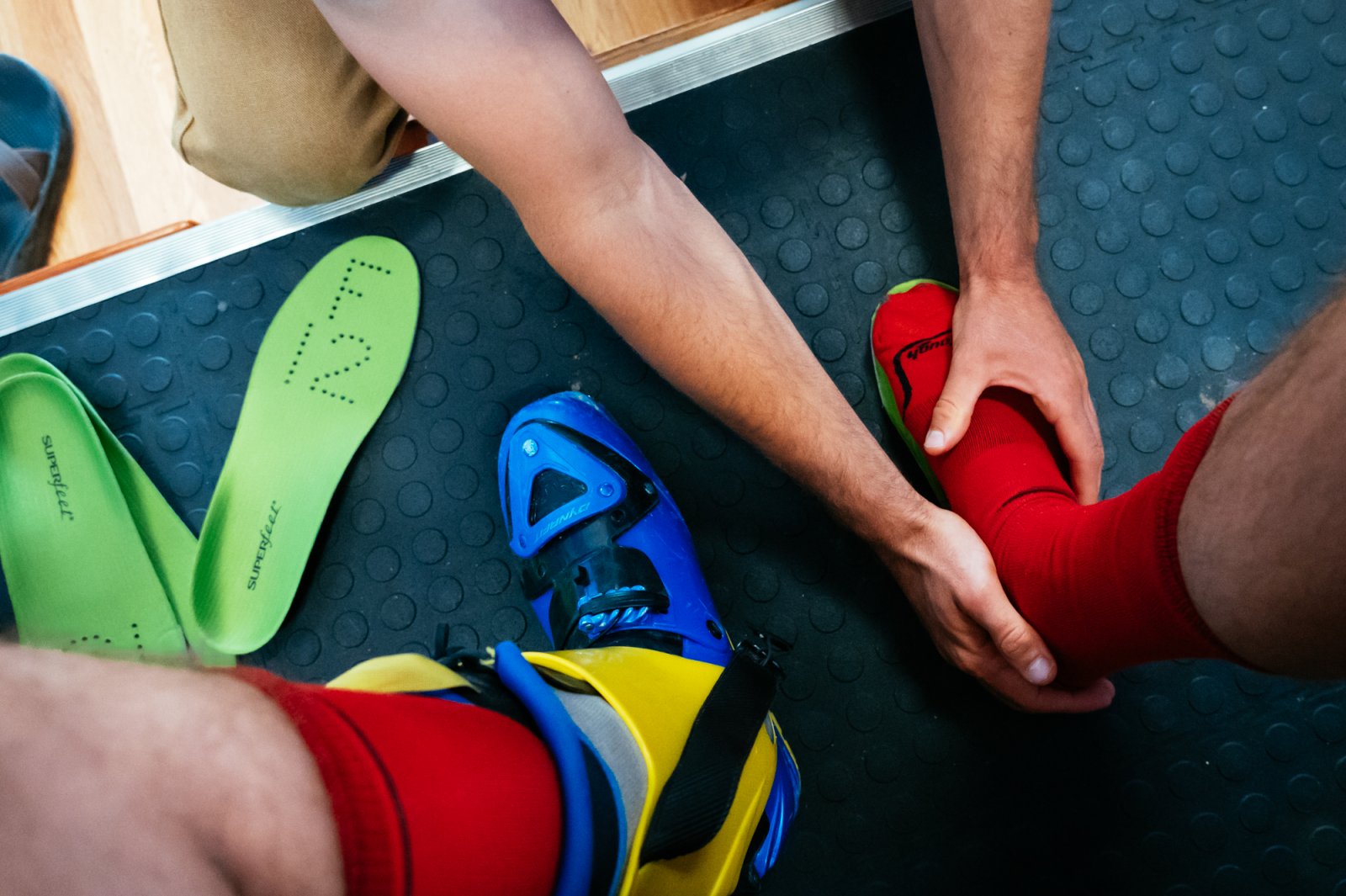11/8/2021 Finding the Perfect Fit: Common Boot Issues and How to Fix Them
When fit correctly, alpine touring boots provide access to pristine environments, untracked snow, and endless smiles with your partners. When boots aren’t fitted correctly, however, the results can be torturous. Because we here at Skimo Co are in the business of keeping you and your feet happy, let’s examine some common boot issues and what you can do to remedy them.

Fit
Before we dive into boot issues, it is important to first understand what the parameters of a “correctly” fitting boot are. The best way to get a perfect fit is to start with a boot that fits as well as possible out of the box. If you need help determining that, come in to the shop for a proper in-person bootfit or reach out to our online bootfitter where we'll help you find the best boot for your needs.
But if you're looking to adjust problematic boots you already own, this preface should enable you to use the guide below to figure out what could be causing the issues you’re experiencing.
It is important to realize that the fit guidelines we list below are that, guidelines. If you find yourself being slightly different from what is listed, it doesn’t necessarily mean you won’t be able to get your boot to fit. However, the further you get away from these guidelines, the less likely you’ll be able to make the boot work. Lastly, it should be noted there are many avenues that lead to the same problem. For example, shin bang can be caused by boots that are too big OR an appropriately sized boot that is too stiff. It may take some work on your end to decipher the root problem.
The Four Variables
There are four components to consider when determining if a boot will work for your foot. These are length, width, heel pocket, and instep height.
To determine length, place your foot into the shell without the liner. While standing, slide your toes to the front of the boot so they are touching but not curling and flex your knee forward. In this position, you ideally should have between .75”-1.25” space between your heel and the back of the shell.
For width, with the liner still out, sit down and slide your heel so that it fits comfortably in the back of the shell. Keeping your foot flat, slide your foot to the outside edge of the boot. You should have a uniform amount of space along the inside contour of your foot that does not exceed more than .5”. If you find yourself consistently touching both sides of the shell during this step, then the boot is likely too narrow (if only a small protrusion contacts both sides, that’s okay - there are many things that can be done to create more space).
While there aren’t many quantifiable measurements that will signify whether the heel pocket or instep height (top of your foot between the ball of your foot and ankle) are appropriate, there are tip offs that they are or aren’t. To determine these, place the liner back in the boot with your insole, and buckle them comfortably.
When you flex into the boot, you should feel that your heel is in place and does not have significant slippage. That’s a good sign that your heel pocket is good to go.
For the instep height, you should feel a consistent yet comfortable pressure. If over a brief period you feel a very intense/crushing pressure on your instep, then look for a new boot. For any boot, it is important that the heel pocket and instep fit well. Overall, with a correctly fit ski boot, you should feel a comfortable but consistent pressure throughout the entirety of the foot, with no major points of specific pressure.
Insoles: the First Piece of the Bootfitting Puzzle

Like a foundation provides support to the walls of a house, insoles support the feet properly in the boot, and should be in place before any modification to the liner or shell takes place. When problem-solving uncomfortable boots - regardless of the issue - you’ll notice that nearly every solution begins with “ First, a properly fit insole should be in place.” We mean it. The wrong insole can range from uncomfortable to downright painful.
At Skimo Co, we typically size insoles with the person sitting so their arches aren’t collapsing under their weight. The goal of an insole is to stop your foot from dropping to the inside (pronation), prevent your arch from collapsing, and to support the foot in a neutral position. If you feel point-specific pressure, arch support dropping off prematurely, or your foot tilting towards the outside (supination), then you’re on the wrong insole.
While some brands keep the thickness of their insoles consistent, others, like Superfeet, do not. Therefore, it is important to consider what the impact of putting in a thinner or thicker insole will have on the fit of your ski boots. For example, if you are trying to fill volume and support the arch, a thicker insole would help to simultaneously solve both issues.
If you are unable to find an insole that properly supports your arch in a needed thickness, then you should consider having custom insoles made, something we're happy to do at our shop. While many will find that an “off the shelf” aftermarket insole will meet their needs, others won’t. If you have a significant size discrepancy between the left and right feet, you injured one foot, or your arches are just too different - then getting a custom insole is the only appropriate choice. It should also be pointed out that feet can change from year to year (such as getting wider). Thus, if you purchased an insole several winters ago, it may no longer be appropriate this season (this is uncommon, though).
Other Considerations:
Other individualized considerations for determining if you’re in the correct boot include appropriate stiffness for your weight and ski style, boot construction (two piece vs cabrio design), the liner that comes with the boot, and the way your calf is cradled by the cuff of the boot. These are all personal preferences so please contact us with any questions!

Now let’s look at some of the most common boot issues and what can be done to solve them. Feel free to scroll down until you find the problem you're experiencing.
Note, many of the solutions require precise adjustments that we strongly recommend trusting to our expert bootfitters (or another reputable shop if you're not local to Utah). Regardless, this list should help give you an idea of what might be causing problems and what a fix might entail.
The Most Common Problems and Solutions
Shin bang (bruising of the shin bone/muscle).
Cause – This is typically caused by a boot that is too big, too stiff, a liner that is too thin over your shin, or doesn’t cradle your shin effectively.
Solutions - First, a properly fitting insole should be in place. Another option is to change the profile of your foot within the boot with a shim or heel lift, helping change where the problematic pressure is applied. Snugging the boot against the shin, such as with a booster strap, can also help solve the problem. Finally, if the first three steps didn’t achieve the desired result, an aftermarket liner can be used to fill volume or introduce more padding between your shin and the cuff of the boot. It should be noted that once you bruise your shin, you’re likely going to stay that way for the duration of the season. So even though you may have fixed the issue, you may not know until the following season. If you are forced to get a new boot to rectify this issue, cabrio (also called “three piece”) boots may be worth considering versus a more traditional two piece boot due to their flex pattern.
Toe bang/losing toenails (toes aggressively contacting the front of the boot)
Cause - This can be caused by a boot that is too big, which allows your toes to repeatedly slide into the front of the boot, or by a boot that is too small, in which your toes are constantly jammed into the front of the boot. If you feel as if your shell fit isn’t too small, the liner may be the problem. Skiing in the “backseat” (not maintaining pressure on your shins) can lead to these issues as well.
Solutions - First, a correctly fitting insole should be in place. If the boot is too big, take steps to reduce the volume (shims, foam, etc…). If the boot is too small, lengthening the shell, thermo-molding the liner, or grinding away plastic can help. Skiing with correct technique if you find yourself skiing backseat will also help significantly.
Lack of control
Cause - There are many reasons an individual may feel no control in their ski boots. It can be from the boots being too big, liner that is packed out/too thin, inappropriate insole, different boot construction than what you’re used to (cabrio vs two piece), loose heel pocket, inappropriate forward lean, too soft or stiff of a boot, or a combination of all of these.
Solutions – First, a correctly fitting insole should be in place. Then, address the underlying cause. If your liner is packed out, get a new liner. If your heel pocket is too loose, use foam to strategically take up volume. Adjust the forward lean if need be. If the performance and/or size of the boot just won't agree with your skiing, you may need to find a new boot altogether that works better for you.
Blisters
Cause - These can be caused by a boot that is too big, an inappropriate sock (such as a sock with a lot of folds, too baggy, multiple layers of socks, etc…), an excess of moisture, pressure point from the shell/liner, or a combination of these.
Solution - First, a properly fit insole should be in place. Second, address the underlying cause. Reduce volume if the boot is too big, use a tighter fitting sock to avoid excess material, manage moisture to keep feet dry, punch the shell to relieve pressure, and/or strategically pack in liner.
Numbness/tingling
Cause - Too much pressure on the instep (top part of the foot above the arch), a boot that is inappropriately small, buckles done up too tightly (especially on the instep or calf), or circulatory issues are the main culprits for causing numbness.
Solution - Find a way to relieve pressure on the instep. This can include loosening buckles between runs, strategically packing out the liner (literally hammer the liner in the spot over your instep), or carefully grind the boot board (removable plastic piece in the bottom of the shell of some boots) to lower your foot in the boot. Thinner insoles can also help. If you have less than .5” of space lengthwise, you’re touching both sides of the shell widthwise, or your instep is agonizingly painful, a new boot also may be necessary. Overall, finding a way to improve circulation is the goal.
Cramping feet
Cause - An insole that is not providing enough support OR has too much support for your arch type, electrolyte imbalance, buckles that are done too snugly, or boots that are too big/small.
Solution - First, an appropriate insole for your arch type should be in place. Then, take steps to address the other potential underlying causes listed above. Do a shell fit as described above to double check that the boots are the right size for you. If your boot has an excess of volume that causes you to flex your feet in order to maintain control, fill the excess volume. If you find your boots are comfortable when loosely buckled, do so while skinning or between runs. As for the electrolyte situation, ensure you're maintaining proper hydration and nutrition to prevent cramping.
Cold Feet
Cause - Typically, cold feet are caused by too thick/thin of boot liner, too thick/thin of sock, boot that is too small/excess pressure on the instep, boot that is buckled too tightly on the calf.
Solution – First, put in a properly fit insole. Using a thinner sock and/or liner can help improve warmth (as this can promote circulation). If you don’t suspect that circulation is an issue, using a slightly thicker sock/liner will be inherently warmer than thinner offerings. Heated socks or neoprene Boot Gloves also are good options. Because of potential fit issues, we don’t recommend using chemical hand warmers in boots.
Bunions, boney growths on the foot, or other unique foot protrusions
Cause - Boots and/or liners that are too tight in a specific area(s), lack of appropriate insole, or packed-out liners that no longer provide adequate padding.
Solution - First, a properly fit insole should be in place as this will help to reduce problematic movement and pressure points within the boot. Then, if the problem persists, consider strategically packing out the liner and boot punching to create more volume over the problem area.
Neuroma (painful irritation of a nerve)
Cause - Typically, this is caused by boots that are too small or point specifically too tight.
Solution - First, an appropriate insole should be present. In addition to a proper insole, a metatarsal pad (supportive pad under the ball of foot) may be appropriate as it can help to reduce pressure on a neuroma by supporting your metatarsal arch. Once these steps have been completed, thermo molding liners and/or punching the boot shells to create a wider toe box may be advantageous. If you have less than .5” of space lengthwise or are aggressively contacting both sides of shell, a new boot may be necessary. Finally, see a medical professional!!
Heel Lift/slop
Cause - This typically occurs if the heel pocket of the boot is inappropriate for your foot, the boot is too large, lack of an insole, or the liner has packed in. Blisters and or a lack of control can result from heel lift.
Solution - A proper insole or heel lift can help raise your heel into the defined heel pocket of your boot, helping lock it in place. A new liner or strategically placed foam can take up volume in the heel area, helping keep your heel down. If the heel pocket is just too inappropriate, you should consider a new boot. In addition, poor skinning technique can lead to heel lift and slop.
Perception
Cause - To folks who aren’t accustomed to tighter fitting footwear, a correctly fit ski boot can seem overly tight. While there is a balance between performance and comfort that is different for every individual, even the most comfortable ski boots, with their unbending rigid exteriors, shouldn’t necessarily feel like bedroom slippers.
Solutions - Understand that ski boots will never achieve the level of comfort of your favorite shoe.

It Needs to Fit, in Order to Fit
When attempting to solve an issue, it is important to realize that if the boot is just too inappropriate, then no amount of the “solutions” listed above will work, and it is time to look for a new boot. It should also be noted that each manufacturer has a different “fit.” So, if you fit into a 26.5 from Tecnica, a 26.5 from Dynafit won’t necessarily fit. To make things even more difficult, different models from the same manufacturer can fit differently (such as the SCARPA F1 vs F1 LT).
It is no secret that skiing is an expensive sport, however, buying boots because they are on sale and not because they fit is a toxic strategy. After all, an ill-fitting boot can negate any fun you would’ve achieved from skiing. If you find yourself needing new boots, our comprehensive online boot fitter is a great tool. As always, please reach out if you have any questions concerning the fit of your boots!
Comments
I'm using Lange XT3 Tour Pro boots, new this season, but have already had a few tours with them with zero issues. However, this weekend's adventure had a lot more horizontal distance than I'm used to. So maybe that is relevant? Initially, I thought that the pain was from the bottom of my heel, but once I had my boot off, pressing my heel didn't cause any pain, only pressing from the side did.
So, any ideas as to diagnosis and possible prevention? Like I wrote, no problems with the boots previously and otherwise fit and ski much better than my previous boots.
Mark
Thanks for the accommodation and insight fullness.
-Javier

11/17/2021
Mind the Heel Gap








